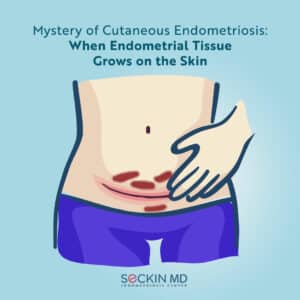Mystery of Cutaneous Endometriosis and Other Endo-Associated Skin Problems

Endometriosis develops by a cascade of inflammatory and fibrotic responses to the menstrual tissue outside the uterus. Such inflammatory reactions usually affect organs in the peritoneal cavity where endometriosis lesions occur. But they can also develop outside of the pelvis in the extraperitoneal tissues as the skin of c-section scar, umbilicus, and groin.
How does endometriosis appear on the skin?
Endometriosis outside the pelvic cavity is quite rare. However, lesions can still affect extra pelvic areas. For example, researchers have reported cases of skin endometriosis in patients who have undergone a C-section near the surgical scar or episiotomy scar.
Diagnosing skin or cutaneous endometriosis is easy, although the lesion can be similar to a keloid or a dermatofibroma. A needle biopsy followed by a histological examination is necessary to confirm that the nodule is endometriosis.
Does the immune system play a role in skin disorders during endometriosis?
Endometriosis lesions have high numbers of mast cells. Mast cells are a class of immune cells that release histamines. They play a role in allergies while also helping in ovulation and menstruation.
Excess histamine production can promote the growth of endometriosis lesions. It can also cause histamine intolerance, manifesting as atopic dermatitis or eczema with dry and itchy skin. Atopic dermatitis, associated with preeclampsia and endometriosis, is also associated with low numbers of circulating natural killer (NK) cells and higher levels of skin lesions.
Hormonal imbalances during endometriosis may also lead to acne-prone skin around the onset of periods. Women with severe teenage acne were shown to have a 20% increased risk of endometriosis compared to those without a severe acne history. Researchers also showed a positive correlation between endometriosis and the presence of inflammatory diseases, including eczema and psoriasis. The likelihood of endometriosis in women with allergies can be as high as 76%.
Pelvic endometriosis itself is not the cause of skin changes (unless related to c-section or abdominal scar endometriosis, as mentioned above). However, the individual’s underlying biology and immunological composition may make them more likely to develop both skin changes and endometriosis.
How do you manage skin-related symptoms?
It is possible to manage many of the skin symptoms during periods by identifying potential triggers leading to them.
Switching to an anti-inflammatory diet under the guidance of a qualified dietician may help minimize symptom triggers. These regimens will not be practical management for these lesions, which need complete excisional removal. For a c-section scar, complete revision of the scar and removal of the mass is the optimal approach. Similarly, the “gold standard” of excisional surgical treatment is removing endometriosis masses and repairing the related groin hernia and umbilical hernia.
Do you have endometriosis and also experience skin problems? Please share your story if you wish by leaving a comment on our post on Facebook or Instagram
Get a Second Opinion
Our endometriosis specialists are dedicated to providing patients with expert care. Whether you have been diagnosed or are looking to find a doctor, they are ready to help.Our office is located on 872 Fifth Avenue New York, NY 10065.
You may call us at (646) 960-3080 or have your case reviewed by clicking here.